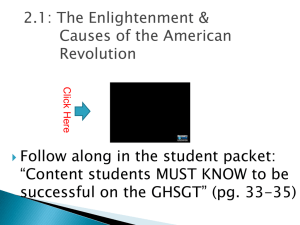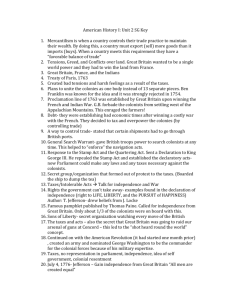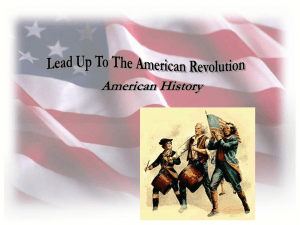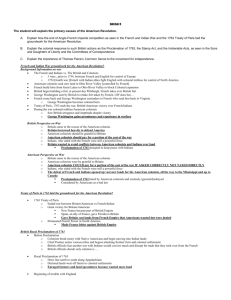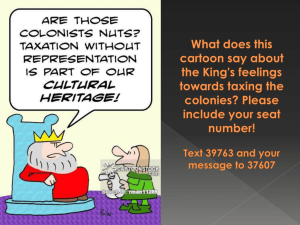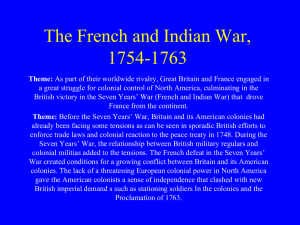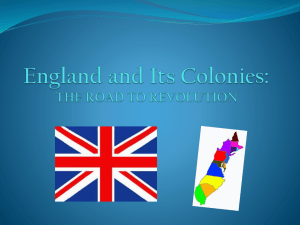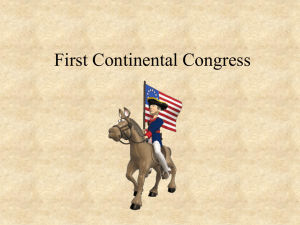APUS Unit 3 Ch.6 Duel for North America PPTx
advertisement
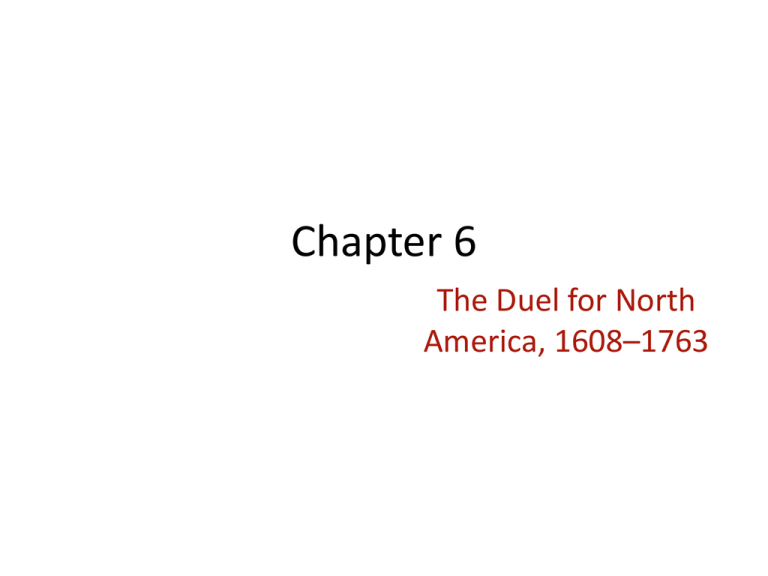
Chapter 6 The Duel for North America, 1608–1763 p112 • Theme: As part of their worldwide rivalry, Great Britain and France engaged in a great struggle for colonial control of North America, culminating in the British victory in the Seven Years’ War (French and Indian War) that drove France from the continent. • Theme: Before the Seven Years’ War, Britain and its American colonies had already been facing some tensions, as can be seen in sporadic British efforts to enforce trade laws and colonial reaction to the peace treaty in 1748. • During the Seven Years’ War, the relationship between British military regulars and colonial militias added to the tensions. • The French defeat in the Seven Years’ War created conditions for a growing conflict between Britain and its American colonies. • The lack of a threatening European colonial power in North America gave the American colonists a sense of independence that clashed with new British imperial demands, such as stationing soldiers in the colonies and the Proclamation of 1763. What divided the colonies in 1754? Essential Question • How did an American identity develop during this period? • How was America different/similar 1775 vs. 1700? • How did Americans differ among each other in 1775? • In light of these two questions, was there, by 1775, an American character and/or culture? Some Developments • Huge surge in colonial population (2 million inhabitants) • Print Revolution • Influence of Enlightenment and Pietism • Wealthy colonists and influx of European goods lead to new material culture • Social Tensions – Limitations on available land in New England – Groups (such as German, Dutch and Scotts-Irish) attempt to maintain religious and cultural identities while competing for political power • Increasing interest in western lands leads to conflict with Native Americans Spirit, Ch.5 Docs A1-4 • How would the authors each respond to the question, “Was there an American character?” What evidence would they use? • Crisis of legitimacy. Suspicion distrust of government • Pluralism, constantly complicated by new arrivals. Pluralism as a fact, and then as a way of seeing American leads to tolerance • Social mobility possible and valued • In light of the above, American character is not a fixed thing, but rather a culture/society with its constituent conflicting parts/people (values/lifestyles). This all leads to a broader conception of national character. • Specific aspects-individualistic, yet community -sense of rights/rights in conflict/insistence on preserving rights/emphasis on rule of law -religion (or not)/multi-faith/practical necessity of tolerance French Settlement • 1598 Edict of Nantes – Granted limited toleration to Protestants in France and ended religious wars – France became the most powerful nation in Europe • 1608 Quebec established -New France comes under the direct control of the king -no representative assemblies or the right to a trial by jury • Detroit founded by Antoine Cadillac to prevent English penetration into the Ohio Valley • Louisiana explored by Robert de La Salle to prevent Spanish penetration into the Gulf of Mexico region – New Orleans established as a fort (1718) Map 6-1 p99 Map 6-2 p100 European Rivalries • King William’s War (1689-1697) • Queen Anne’s War (1702-1713) – Colonists fought French coureurs de bois • Indians recruited by each side • Spain allied with France • Colonists captured Port Royal in Acadia • Treaty of Utrecht (1713) – Britain received Nova Scotia, Newfoundland and Hudson Bay • King George’s War (1744-1748) (War of Austrian Succession) – Spain allied with France – Colonists capture French fortress of Louisbourg – In the treaty of 1748, Louisbourg was given back to the French which upset the New Englanders Map 6-3 p101 Map 6-4 p102 Table 6-1 p101 Table 6-2 p103 French and Indian War (1754-1763) Seven Years’ War (1756-1763) • Began as rivalry over Ohio Valley • Washington sent to Ohio territory by governor of Virginia – Washington attacked French troops – Surrendered at Fort Necessity • Became a global war • 1759 Quebec fell to the British Map 6-5 p104 Map 6-6 p105 Albany Plan of Union • 1754 British government summoned an intercolonial congress in Albany, NY • Seven colonies sent delegates • Purpose was to keep Iroquois allied with the British • Benjamin Franklin proposed a plan for colonial home rule that was adopted by the delegates but which never came to fruition p106 Map 6-7a p108 Treaty of Paris (1763) • France eliminated from North American continent • Spain received as compensation transMississippi Louisiana and New Orleans • Great Britain emerged as the dominant power in North America and the leading naval power in the world. Map 6-7b p108 Consequences • • • • Colonial self-esteem raised Colonists received military experience British no longer seen as invincible Tensions developed between British officers and colonists. Colonists were looked upon with contempt • British officials upset that colonists did not fully support the common cause • War did encourage some colonial unity • French and Spanish threat to the colonies was eliminated/reduced • Indians lost the ability to play off the Europeans against each other • Colonists had a new sense of destiny as a growing people with a continent open before them Proclamation of 1763 • 1763 Pontiac’s Uprising – Ottawa chief Pontiac led several tribes against the British in the Ohio country, killing over 2000 soldiers and settlers • Proclamation prohibited settlement in the area beyond the Appalachians • Colonists defied the proclamation and pushed westward – Attempt to prevent another uprising Map 6-8 p110
